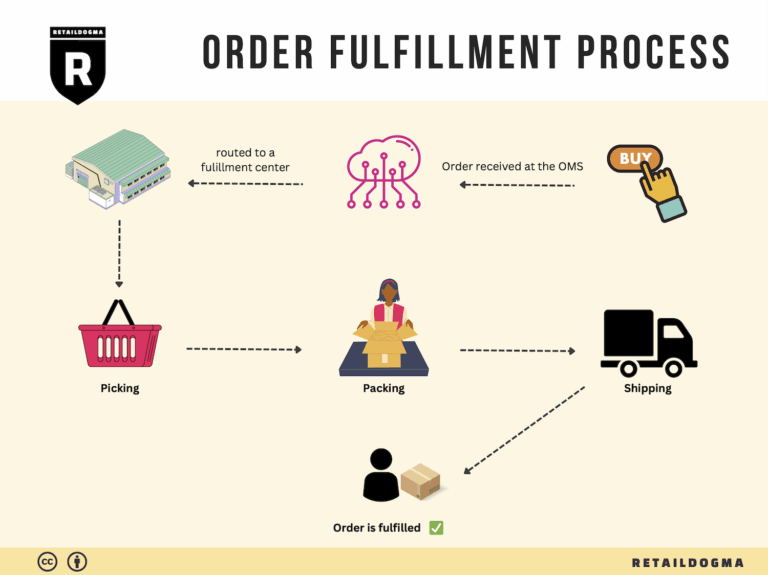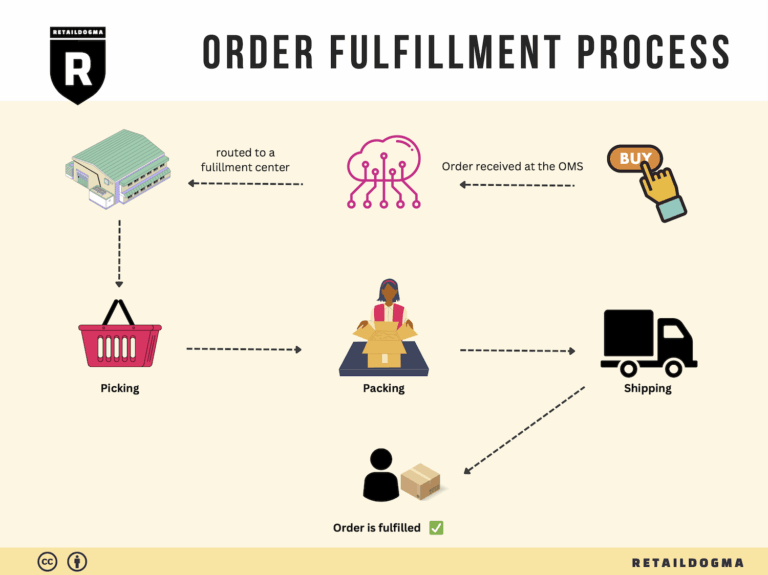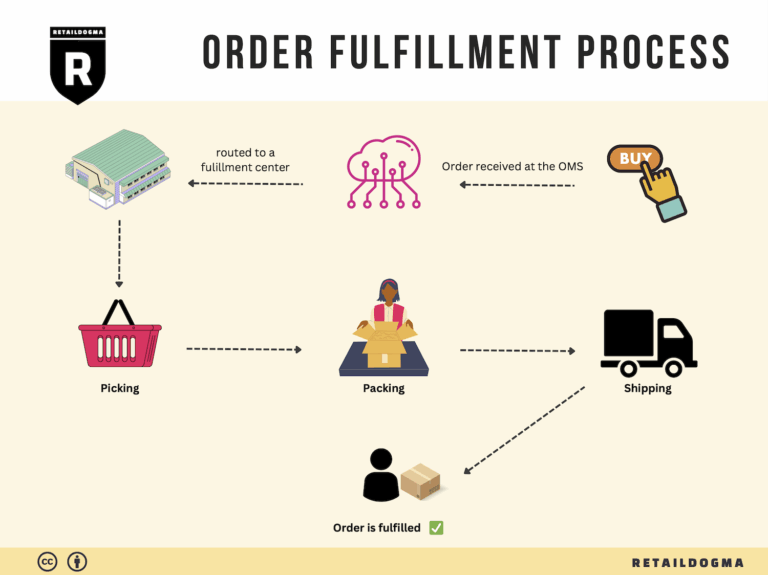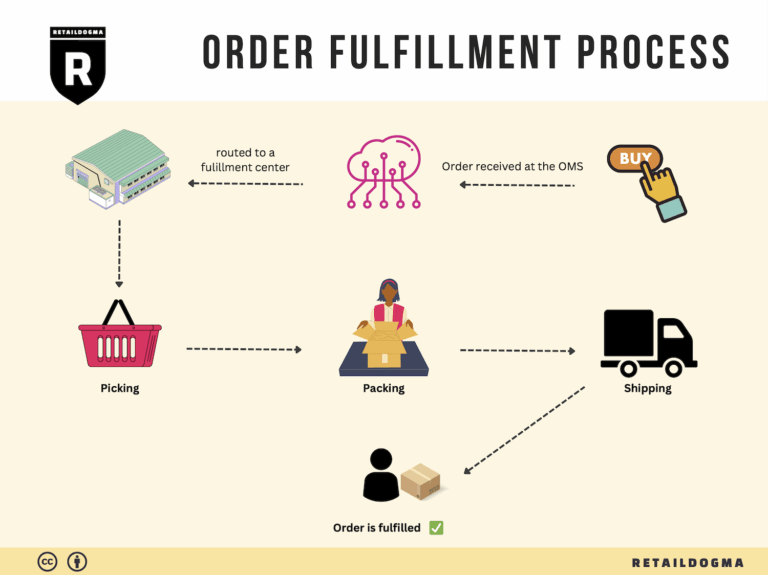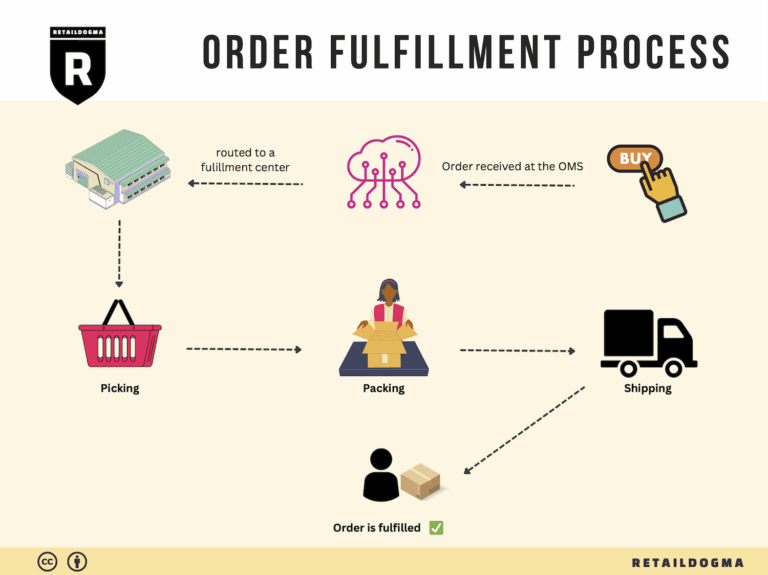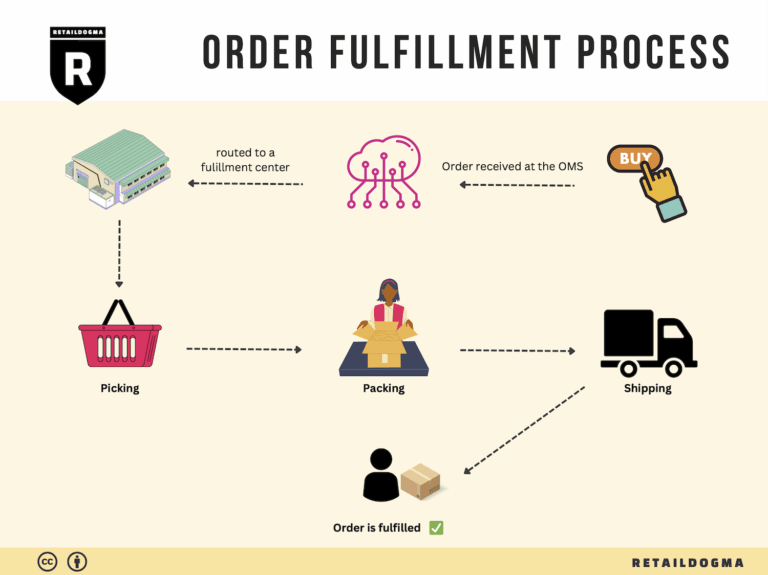How Order Fulfillment Works: A Step-by-Step Guide for Businesses
What is E-commerce Fulfillment? An Introduction for Growing Businesses
Understanding E-commerce Fulfillment
For many growing e-commerce businesses, the journey from a customer placing an order to that order arriving at their doorstep can often feel overwhelming. Packing, shipping, and managing inventory can quickly become a logistical nightmare, detracting from your ability to focus on scaling your business. This is where e-commerce fulfillment comes into play—a crucial process that involves getting products into the hands of customers efficiently and effectively.
At its core, e-commerce fulfillment refers to the complete process of receiving, storing, picking, packing, and shipping products to customers. It’s not just about getting the product out the door; it’s about doing it in a way that enhances the customer experience and supports your business growth. As your sales increase, so does the complexity of your logistics, making it essential to understand and implement a robust fulfillment strategy.
In this guide, we’ll explore various fulfillment models, such as Third-Party Logistics (3PL) and Fulfillment by Amazon (FBA), helping you identify which option aligns best with your business needs. We will delve into the core services offered by these fulfillment providers, including inventory management, order processing, and shipping logistics. Understanding these services will empower you to make informed decisions about which provider can best support your growth trajectory.
Choosing the right fulfillment partner is a critical step in scaling your e-commerce operations. We’ll discuss key factors to consider, such as geographical reach, technology integration, and customer service capabilities. Each of these elements can significantly impact your efficiency and customer satisfaction, so it’s essential to weigh them carefully.
Additionally, we will address pricing structures associated with various fulfillment options. Understanding the cost implications will help you budget effectively and choose a partner that offers the best value without compromising service quality.

Ultimately, this guide aims to empower you, the business owner, to make smart, informed decisions about your logistics. By demystifying the e-commerce fulfillment landscape, we hope to equip you with the knowledge necessary to streamline your operations, enhance customer satisfaction, and drive sustainable growth. Whether you’re just starting out or looking to scale, mastering fulfillment can be a game-changer for your e-commerce success.
What You’ll Learn In This Guide
- What is E-commerce Fulfillment? An Introduction for Growing Businesses
- The Order Fulfillment Process: From ‘Buy’ Button to Customer’s Door
- Comparing Fulfillment Models: In-House vs. 3PL vs. Dropshipping
- A Deep Dive into Amazon FBA: Pros, Cons, and Who It’s For
- Core Services Offered by Fulfillment Centers
- How to Choose a Fulfillment Partner: A 6-Point Checklist
- Understanding Fulfillment Pricing: A Breakdown of Common Fees
- Frequently Asked Questions (FAQs) about Fulfillment
- Conclusion: Is Outsourcing Fulfillment the Right Move for Your Business?
- Important Disclaimer
The Order Fulfillment Process: From ‘Buy’ Button to Customer’s Door
1. Receiving Inventory
The order fulfillment process begins with the receiving of inventory at the fulfillment center. This step involves accepting shipments from suppliers, checking the accuracy of received goods against purchase orders, and inspecting them for any damage. Key terms associated with this step include SKU (Stock Keeping Unit), which is a unique identifier for each product that facilitates tracking and inventory management.
This step is crucial for several reasons. First, accurate receiving ensures that the inventory counts are correct, which is essential for maintaining stock levels and preventing stockouts. Second, it allows for the identification of discrepancies early in the supply chain, reducing the risk of customer dissatisfaction due to incorrect or damaged products. Effective inventory management begins here, setting the stage for subsequent steps in the fulfillment process.
2. Warehouse Storage
Once inventory is received, it moves into the warehouse storage phase. Products are organized and stored in designated locations within the fulfillment center. This organization can be based on various strategies, such as FIFO (First In, First Out), LIFO (Last In, First Out), or zone-based storage. The use of location codes and bin numbers is essential to facilitate easy retrieval later.
The importance of this step lies in its impact on efficiency and speed. Properly organized storage minimizes the time spent locating items during the picking process, which directly affects order processing times. An efficient storage system also helps in maximizing warehouse space, ensuring that businesses can scale their operations without needing additional facilities.
3. Order Picking
The next step is order picking, where items are selected from their storage locations based on customer orders. This process is often guided by pick lists, which detail the items and quantities needed for each order. Depending on the volume of orders and the layout of the warehouse, various picking methods can be employed, such as single order picking, batch picking, or zone picking.
Order picking is a critical step in the fulfillment process as it directly influences order accuracy and speed. An efficient picking process ensures that customers receive the correct items in a timely manner, fostering positive customer experiences. Additionally, investing in technologies such as barcode scanners or pick-to-light systems can enhance the picking efficiency, reducing human error and increasing throughput.
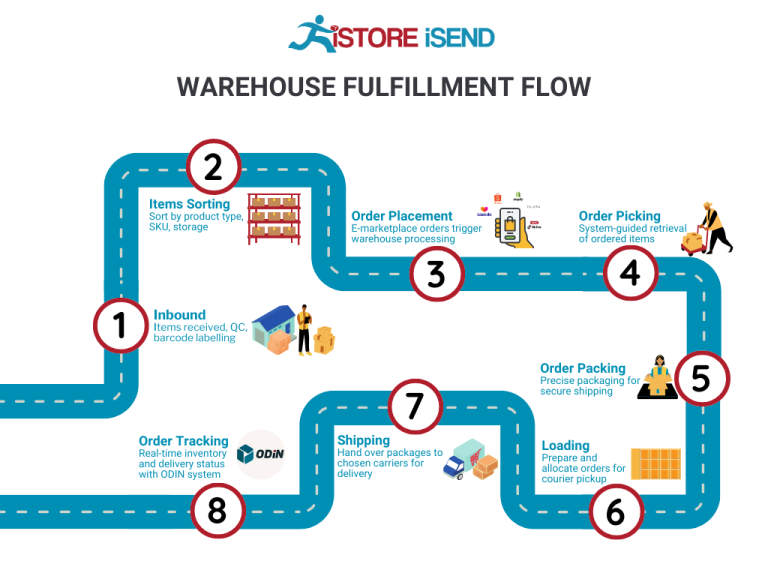
4. Order Packing
After the items have been picked, they move to the order packing stage. This involves securely packing the items for shipment, which includes choosing appropriate packaging materials, adding packing slips, and ensuring that the products are protected during transit. Key considerations during this stage include dimensional weight pricing, which affects shipping costs based on package size rather than weight.
Packing is vital because it safeguards the products against damage during shipping and helps optimize shipping costs. Properly packed orders also enhance the presentation of the product when it reaches the customer, contributing to a positive brand image. Furthermore, accurate packing ensures that the correct items are sent out, which helps in minimizing returns and exchanges.
5. Shipping & Delivery
The final step in the order fulfillment process is shipping and delivery. Once packed, orders are labeled and handed over to shipping carriers for delivery to customers. This stage can involve various shipping options, including standard, expedited, and same-day delivery. A critical term here is tracking number, which allows both the business and the customer to monitor the shipment’s progress.
Shipping and delivery are crucial as they represent the last touchpoint between the business and the customer. Timely and reliable delivery can significantly influence customer satisfaction and loyalty. Additionally, optimizing shipping routes and methods can lead to cost savings for the business, enhancing overall profitability. Effective management of this step ensures that the customer receives their order as expected, closing the fulfillment loop and paving the way for repeat business.
By understanding and optimizing each of these steps, e-commerce businesses can enhance their order fulfillment processes, leading to improved customer satisfaction and increased operational efficiency.
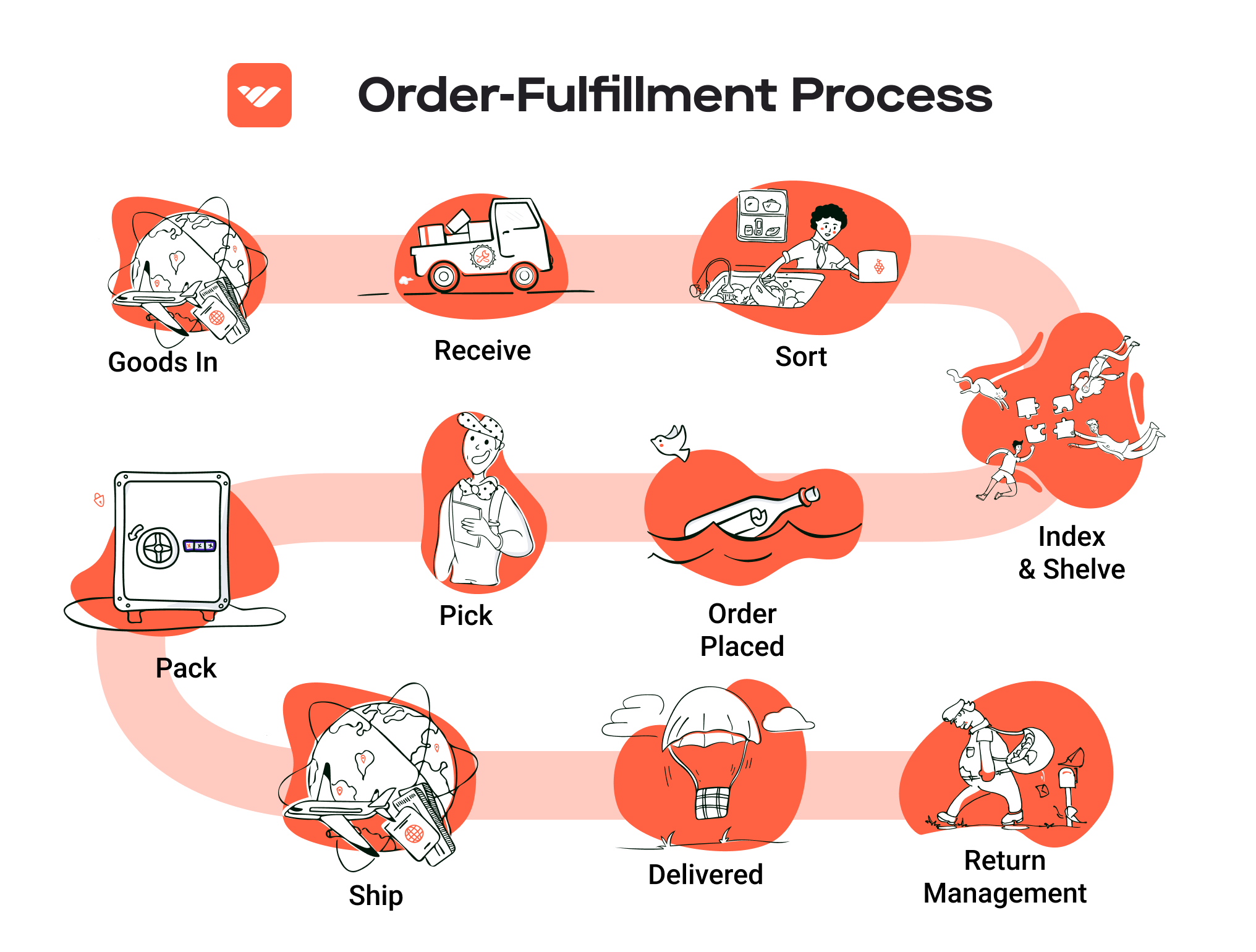
Comparing Fulfillment Models: In-House vs. 3PL vs. Dropshipping
Fulfillment Model Comparison Table
| Model | Who Handles Inventory | Best For (Business Stage) | Key Advantage | Key Disadvantage |
|---|---|---|---|---|
| In-House Fulfillment | The business itself | Established businesses | Full control over inventory and processes | High overhead costs |
| Third-Party Logistics (3PL) | Third-party providers | Growing businesses | Scalability and access to expertise | Less control over inventory |
| Dropshipping | Suppliers | Startups and small businesses | Low upfront investment and risk | Lower profit margins and potential quality control issues |
In-House Fulfillment
In-house fulfillment refers to the process where a business manages its own warehousing, inventory management, and order fulfillment. This model is typically favored by established businesses that have the capital and resources to invest in their own logistics infrastructure. The key advantage of in-house fulfillment is the complete control it offers over the entire process—from inventory management to shipping. Businesses can implement tailored processes that align with their specific operational needs and customer service standards. However, this model comes with significant disadvantages, primarily high overhead costs associated with staffing, warehousing, and technology. Additionally, in-house fulfillment can limit scalability; as demand fluctuates, businesses may struggle to adjust their operations quickly.
Third-Party Logistics (3PL)
Third-party logistics (3PL) involves outsourcing logistics and fulfillment tasks to specialized providers. This model is particularly beneficial for growing businesses that require flexibility and scalability without the burden of managing inventory and shipping logistics in-house. A key advantage of using a 3PL is the ability to leverage the provider’s expertise, technology, and infrastructure, which can lead to improved operational efficiency and reduced shipping times. 3PLs often have established relationships with carriers, which can result in cost savings for businesses. However, a notable downside is the reduced control over inventory and fulfillment processes, which can lead to issues with order accuracy and customer satisfaction if the 3PL does not meet the business’s service standards. Businesses must also carefully select a reliable 3PL partner to mitigate risks associated with service level inconsistencies.
Dropshipping
Dropshipping is a fulfillment method where a business does not keep products in stock but instead transfers customer orders directly to a supplier, who then ships the products to the customer. This model is particularly appealing for startups and small businesses due to its low upfront investment and minimal risk. Since there is no need to invest in inventory, entrepreneurs can focus on marketing and customer acquisition without the burden of warehousing costs. However, dropshipping has its disadvantages, such as lower profit margins due to reliance on supplier pricing and potential quality control issues, as businesses often lack direct oversight of the products being shipped. Additionally, fulfillment times can be longer, leading to potential dissatisfaction among customers if the supplier does not maintain efficient shipping practices. As a result, while dropshipping can be a practical entry point for new businesses, it may not be sustainable for long-term growth without careful management of supplier relationships and product quality.
In summary, each fulfillment model presents distinct advantages and disadvantages that e-commerce businesses must evaluate based on their stage of growth, operational capabilities, and customer service goals. Understanding these models allows business owners to make informed decisions that align with their strategic objectives and market demands.
A Deep Dive into Amazon FBA: Pros, Cons, and Who It’s For
Understanding Fulfillment by Amazon (FBA)
Fulfillment by Amazon (FBA) is a service provided by Amazon that allows e-commerce sellers to store their products in Amazon’s fulfillment centers. Amazon then takes care of storage, packaging, and shipping of the products, as well as customer service and returns. This service enables sellers to leverage Amazon’s vast logistics network and customer base, simplifying the complexities of order fulfillment.
How FBA Works
-
Setup: Sellers create an Amazon seller account and register for the FBA program. They then prepare their products according to Amazon’s guidelines.
-
Inventory Shipment: Sellers ship their products to designated Amazon fulfillment centers. Amazon provides specific addresses for shipping based on the seller’s inventory and geographic location.
-
Storage: Once products arrive at the fulfillment center, they are stored until sold. Amazon manages the inventory and tracks stock levels.
-
Order Processing: When a customer orders a product, Amazon handles the picking, packing, and shipping. Orders are typically processed quickly, with many eligible for same-day or next-day delivery.
-
Customer Service: Amazon takes care of customer inquiries, returns, and refunds, allowing sellers to focus on their core business operations.
-
Reporting: Sellers can access detailed reports on inventory levels, sales metrics, and customer feedback through their Amazon seller dashboard.
Pros of Using FBA
Prime Eligibility
One of the most significant advantages of FBA is that products become eligible for Amazon Prime. Prime members enjoy benefits like free two-day shipping, which can significantly increase a seller’s visibility and sales potential.
Customer Trust
Products fulfilled by Amazon benefit from Amazon’s reputation for reliability and customer service. Customers tend to trust items that are sold and shipped by Amazon, which can lead to higher conversion rates.
Multi-Channel Fulfillment
FBA is not limited to Amazon sales alone. Sellers can use FBA to fulfill orders from other platforms, such as their own e-commerce websites or eBay. This capability allows for a streamlined inventory management process across different sales channels.
Scalable Operations
With FBA, sellers can scale their operations quickly. As sales increase, sellers can rely on Amazon’s infrastructure to handle increased order volumes without the need for significant investment in warehousing and logistics.
Detailed Analytics
Amazon provides sellers with access to comprehensive analytics tools that help track sales performance, inventory levels, and customer engagement. This data can be instrumental in making informed business decisions.
Cons of Using FBA
High Fees
FBA services come with various fees, including storage fees for inventory stored in Amazon’s fulfillment centers and fulfillment fees for each order processed. These costs can add up quickly, particularly for sellers with lower-margin products.
Strict Inventory Rules
Amazon has specific rules regarding inventory management, including limits on the quantity of products that can be stored and strict guidelines for product preparation. Failure to comply can result in additional fees or penalties.
Commingling Risks
When using FBA, sellers’ inventory may be commingled with that of other sellers. This means that if a customer returns a product, it could be difficult to ensure that the returned item is the same as the one originally sold, leading to potential issues with quality control and customer satisfaction.
Limited Control Over Fulfillment
Sellers relinquish a degree of control over the fulfillment process. Issues such as shipping delays, inventory mismanagement, or customer service challenges are handled by Amazon, which can sometimes lead to frustration for sellers.
Complexity in Returns Management
While Amazon handles customer returns, sellers may find it challenging to manage returns effectively, especially if they want to understand the reasons behind returns or address quality issues.
Who is FBA Best For?
Fulfillment by Amazon can be an excellent option for various types of sellers, including:
-
Small to Medium-Sized Businesses: Companies that want to scale their operations without the burden of managing logistics and customer service can benefit significantly from FBA.
-
Brands Looking to Increase Visibility: Sellers who want to leverage Amazon’s massive customer base and Prime membership to increase product visibility and sales.
-
E-commerce Entrepreneurs: New sellers who may lack the infrastructure for order fulfillment can use FBA to focus on product sourcing and marketing.
-
Multi-Channel Sellers: Businesses that sell on multiple platforms and want a streamlined fulfillment process can take advantage of FBA’s multi-channel fulfillment capabilities.
-
Sellers of High-Turnover Products: Those with products that have a high turnover rate can benefit from FBA, as it allows them to scale quickly and efficiently without the need for significant investment in logistics.
In conclusion, while Fulfillment by Amazon offers numerous advantages that can help scale your e-commerce business, it is essential to weigh the pros and cons carefully. Understanding how FBA fits into your overall business strategy is crucial for making an informed decision that aligns with your goals.
Core Services Offered by Fulfillment Centers
Inventory Management & Warehousing
Inventory management is a crucial service provided by fulfillment centers that ensures your products are stored, tracked, and organized efficiently. Fulfillment centers utilize advanced inventory management systems that offer real-time visibility into stock levels, allowing businesses to manage their inventory effectively and minimize the risk of stockouts or overstock situations.
By employing techniques like FIFO (First In, First Out) or LIFO (Last In, First Out), fulfillment centers help businesses optimize their inventory turnover rates. This is particularly beneficial for e-commerce businesses as it ensures that products are sold before they become obsolete or expire, especially in sectors dealing with perishable goods.
The benefits of effective inventory management include reduced carrying costs, improved cash flow, and the ability to make informed purchasing decisions based on accurate data analytics. Additionally, with warehouses strategically located in key regions, fulfillment centers can help businesses reduce shipping times and costs, enhancing customer satisfaction.
Pick and Pack Services
Pick and pack services are integral to the order fulfillment process. This service involves selecting items from the warehouse shelves (picking) and preparing them for shipment (packing) based on customer orders. Fulfillment centers employ skilled staff and technology to ensure accuracy and speed in this process.
The pick and pack operation can be tailored to various business needs, such as bulk orders, single-item shipments, or mixed product orders. By leveraging automated systems and barcode scanning, fulfillment centers minimize human error and ensure that the correct items are dispatched to customers.
The key benefits of pick and pack services include faster order processing times, improved order accuracy, and the ability to scale operations seamlessly. As e-commerce businesses experience fluctuations in demand, fulfillment centers can quickly adjust their pick and pack capabilities to accommodate seasonal spikes or promotional events, ensuring that customer expectations are consistently met.
Kitting and Assembly
Kitting and assembly is a value-added service that allows e-commerce businesses to combine multiple products into a single kit or assemble items before shipping. This service is particularly useful for businesses that offer product bundles, promotional packages, or custom orders, providing a streamlined approach to fulfilling complex orders.
Fulfillment centers can handle various kitting tasks, such as assembling gift sets, bundling promotional items, or creating specialized packaging for unique customer requests. By outsourcing kitting and assembly to fulfillment centers, businesses can save time and reduce labor costs associated with these tasks.
The benefits of kitting and assembly services include enhanced product presentation, reduced shipping costs through consolidated packaging, and the ability to offer customers unique product combinations that can differentiate a brand in a competitive market. This flexibility allows e-commerce businesses to adapt quickly to changing customer preferences and market trends.
Returns Management (Reverse Logistics)
Returns management, often referred to as reverse logistics, is a critical service offered by fulfillment centers that focuses on the efficient processing of returned items. With the rise of e-commerce, managing returns effectively has become increasingly important, as customers expect hassle-free return processes.
Fulfillment centers streamline the returns process by providing clear instructions for customers, inspecting returned items, and processing refunds or exchanges promptly. They also analyze return data to identify trends and common issues, enabling businesses to make informed decisions about product quality and customer satisfaction.
The benefits of effective returns management include improved customer loyalty, reduced operational costs associated with handling returns, and valuable insights into product performance. By efficiently managing returns, e-commerce businesses can enhance their overall customer experience, which is crucial for retaining customers in a highly competitive online marketplace.
In summary, leveraging the core services offered by fulfillment centers allows e-commerce businesses to enhance their operational efficiency, improve customer satisfaction, and ultimately drive growth. As businesses scale, partnering with a reliable fulfillment center can provide the necessary infrastructure and expertise to navigate the complexities of order fulfillment and logistics effectively.
How to Choose a Fulfillment Partner: A 6-Point Checklist
Location & Warehouse Network
The geographical location of your fulfillment partner’s warehouses can significantly influence your shipping times and costs. An ideal partner should have facilities strategically placed near your target customer base.
Why It’s Important:
– Shipping Speed: Proximity to your customers can reduce transit times, leading to higher customer satisfaction and repeat business.
– Cost Efficiency: Longer shipping distances can increase costs, particularly for expedited shipping options.
Questions to Ask:
– Where are your warehouses located, and how many do you operate?
– Can you provide a map of your network and details on shipping zones?
– How do you handle shipping to remote areas?
Technology & Integrations
A robust technological infrastructure can streamline operations, enhance visibility, and improve inventory management. Your fulfillment partner should offer software that integrates seamlessly with your e-commerce platforms.
Why It’s Important:
– Real-Time Tracking: Enables you and your customers to monitor shipments.
– Inventory Management: Helps prevent stockouts or overstock situations.
– Automation: Reduces manual errors and speeds up order processing.
Questions to Ask:
– What software do you use for order management and tracking?
– Can your system integrate with my existing e-commerce platform (e.g., Shopify, WooCommerce)?
– Do you offer API access for custom integrations?
Specializations (e.g., Cold Storage, Oversized Items)
Not all fulfillment partners can accommodate every type of product. Depending on your inventory, it may be crucial to partner with a provider that has specific capabilities.
Why It’s Important:
– Product Suitability: Ensures your products are stored and handled according to their requirements (e.g., temperature-sensitive items).
– Operational Efficiency: Specialized facilities can streamline processes and minimize damage.
Questions to Ask:
– Do you have specialized facilities for products like cold storage or oversized items?
– What measures do you take to ensure the integrity of sensitive products?
– Can you handle custom packaging or assembly needs?
Scalability & Capacity
As your business grows, your fulfillment needs will evolve. Your partner should be able to scale operations in response to your changing demands.
Why It’s Important:
– Flexibility: A partner with scalable solutions can accommodate seasonal spikes or sudden growth without compromising service quality.
– Long-Term Partnership: Ensures that your fulfillment needs are met as your business expands.
Questions to Ask:
– How do you handle peak seasons or unexpected increases in order volume?
– What is your maximum capacity, and how quickly can you scale operations?
– Do you have a plan in place for managing growth and excess inventory?
Pricing and Contracts
Understanding the pricing structure and contract terms is essential for budgeting and avoiding unexpected costs. Look for transparency in pricing and flexibility in contract terms.
Why It’s Important:
– Cost Management: Clear pricing helps you maintain control over your expenses.
– Contract Flexibility: Flexibility in contracts can protect you from long-term commitments that may not suit your evolving business needs.
Questions to Ask:
– Can you provide a detailed breakdown of your pricing structure (e.g., storage fees, shipping costs)?
– Are there any hidden fees I should be aware of?
– What are your contract terms, and do you offer month-to-month options?
Customer Support & Reviews
Reliable customer support is critical for addressing issues promptly and ensuring smooth operations. Investigating reviews can provide insights into the partner’s reliability and service quality.
Why It’s Important:
– Responsive Support: Effective customer support can resolve issues quickly, minimizing disruptions in your operations.
– Reputation: Reviews can reveal the partner’s track record and help you gauge their reliability.
Questions to Ask:
– What level of customer support do you provide (e.g., dedicated account manager, 24/7 support)?
– Can you share testimonials or case studies from current or past clients?
– How do you handle disputes or service failures?
Conclusion
Choosing the right fulfillment partner is a critical decision that can impact your e-commerce business’s efficiency and customer satisfaction. By following this checklist, you can systematically evaluate potential partners and make an informed choice that aligns with your operational needs and growth aspirations. Prioritize the aspects that are most relevant to your business, and don’t hesitate to ask detailed questions to ensure that the partner you choose can deliver the level of service you require as you scale your operations.
Understanding Fulfillment Pricing: A Breakdown of Common Fees
Initial Setup Fees
Initial setup fees are typically charged when you first engage with a fulfillment service. These fees cover the administrative costs associated with onboarding your products into their system. The setup process may include creating your account, integrating your e-commerce platform, and configuring your product listings.
Calculation: The initial setup fee can vary significantly among providers. It may be a flat fee or based on the number of SKUs (Stock Keeping Units) you have. For example, some fulfillment centers might charge a one-time fee of $50 to $500, depending on the complexity of your inventory and the level of service provided. It’s crucial to clarify what is included in this fee to avoid unexpected costs later.
Receiving Fees
Receiving fees are charged when your inventory arrives at the fulfillment center. These fees cover the labor and resources required to unload, inspect, and store your products.
Calculation: Receiving fees are generally calculated based on the number of pallets or boxes received. For example, a fulfillment center might charge $20 per pallet or $5 per box. Some providers may have tiered pricing based on volume; thus, the more you send, the less you may pay per unit. Ensure you understand how the provider defines a “pallet” or “box” to accurately forecast costs.
Storage Fees (per pallet/bin)
Storage fees are incurred for the physical space your inventory occupies within the fulfillment center. These fees are typically charged on a monthly basis and can vary depending on the size and type of storage used.
Calculation: Storage fees are usually calculated per pallet or per bin, often ranging from $10 to $40 per month for a pallet, depending on the location and demand for space. Some fulfillment centers may charge additional fees for long-term storage if products remain in their facility beyond a specified period, often six months. It’s advisable to regularly review your inventory levels to avoid incurring unnecessary long-term storage costs.
Pick & Pack Fees (per item/order)
Pick and pack fees are charged for the labor involved in picking your items from storage and packing them for shipment to customers. This fee is crucial for understanding the cost associated with fulfilling individual orders.
Calculation: Pick and pack fees can be structured in various ways; some providers charge a flat fee per order, while others may charge based on the number of items picked. For instance, a typical fee could be $1.50 per order plus $0.25 per item. If you have a high volume of orders with multiple items, these fees can accumulate quickly. When negotiating with fulfillment providers, consider their pricing structure to find the most cost-effective solution for your order profile.
Shipping Fees
Shipping fees cover the cost of transporting your products from the fulfillment center to your customers. These fees can vary widely based on several factors, including the shipping carrier, destination, package weight, and dimensions.
Calculation: Shipping fees are typically calculated based on weight and distance, and may include additional surcharges for dimensions, zones, or special handling. For example, a provider might charge $5 for a 1 lb package sent within the same state, but $15 for the same package shipped across the country. Many fulfillment centers have partnerships with carriers and may offer discounted rates, so it’s worthwhile to compare these options to find the best shipping rates for your business.
Tips for Getting an Accurate Quote
-
Be Transparent About Your Needs: Provide potential fulfillment partners with detailed information about your product types, volumes, and order frequency. The more they understand your business, the more accurately they can quote you.
-
Request Detailed Pricing Breakdowns: Ask for a comprehensive list of all fees, including any potential hidden costs. Ensure you understand what is included in each fee.
-
Consider Seasonal Variations: If your business has peak seasons, ask how fees might change during those times, as many fulfillment centers adjust their rates based on demand.
-
Negotiate Terms: Don’t hesitate to negotiate terms, especially if you expect a high volume of orders. Many providers are willing to offer discounts or flexible pricing structures to secure your business.
-
Evaluate Contract Terms: Before signing any agreements, carefully review the terms related to fees, especially regarding storage and long-term costs. Understanding these terms upfront can prevent costly surprises later on.
By understanding these common fulfillment pricing models and following these tips, e-commerce business owners can better navigate the complexities of fulfillment costs and make informed decisions that support their growth strategies.
Frequently Asked Questions (FAQs) about Fulfillment
1. What is Amazon Fulfillment Center FAT2?
Amazon Fulfillment Center FAT2 is a distribution center located in Visalia, California, designed to streamline the storage, packaging, and shipping of products sold through Amazon’s platform. Opened in August 2021, FAT2 plays a critical role in Amazon’s logistics network, enabling faster delivery times and improved inventory management for sellers using Fulfillment by Amazon (FBA).
2. How does the fulfillment process work at FAT2?
At FAT2, the fulfillment process begins when products are received from sellers. These items are then stored in the center until an order is placed. Once an order is received, items are picked from inventory, packed securely, and shipped to customers. This process is supported by advanced technology and automated systems to ensure efficiency and accuracy.
3. What’s the difference between a warehouse and a fulfillment center?
A warehouse primarily focuses on storing goods for long periods, often with little movement, while a fulfillment center is designed for quick processing and shipping of orders. Fulfillment centers like FAT2 incorporate technology and systems to handle the rapid turnover of products, ensuring that orders are fulfilled promptly.
4. What is a 3PL (Third-Party Logistics)?
A 3PL is a service provider that manages logistics and supply chain functions for businesses. This can include warehousing, fulfillment, inventory management, and shipping. Companies often partner with 3PLs to scale their operations without investing heavily in their own logistics infrastructure.
5. How much do fulfillment services cost?
The cost of fulfillment services varies widely based on several factors, including the size and weight of products, storage needs, order volume, and specific services required (like packaging and shipping). Typically, costs may include storage fees, picking and packing fees, and shipping fees. It’s advisable to request quotes from fulfillment centers to get a precise estimate tailored to your business needs.
6. What types of products can be stored and fulfilled at FAT2?
FAT2 can handle a wide range of products, including electronics, clothing, household items, and more. However, there are restrictions on hazardous materials and certain high-value items. Sellers should consult Amazon’s guidelines for a comprehensive list of acceptable products for fulfillment.
7. Can I track my inventory stored at FAT2?
Yes, Amazon provides sellers with access to tools and dashboards that allow for real-time tracking of inventory levels stored at FAT2. This visibility helps sellers manage stock levels effectively and plan for restocking as needed.
8. What are the benefits of using FAT2 for fulfillment?
Utilizing FAT2 for fulfillment offers several benefits, including faster shipping times, access to Amazon’s extensive logistics network, improved inventory management, and reduced shipping costs due to economies of scale. Additionally, sellers can leverage Amazon’s customer service for returns and inquiries.
9. How does FAT2 handle returns?
FAT2 follows Amazon’s standardized return process, which allows customers to return products easily. Once a return is initiated, the fulfillment center processes the returned items, inspects them, and either restocks them or disposes of them according to Amazon’s policies.
10. How can I get started with using FAT2 for my e-commerce business?
To start using FAT2, you need to register for an Amazon Seller account and enroll in Fulfillment by Amazon (FBA). Once enrolled, you can ship your products to FAT2, and Amazon will handle the fulfillment process. It’s important to familiarize yourself with Amazon’s guidelines and best practices for FBA to ensure a smooth transition.
Conclusion: Is Outsourcing Fulfillment the Right Move for Your Business?
Evaluating the Benefits of Outsourcing Fulfillment
Outsourcing fulfillment can be a game-changer for e-commerce businesses looking to scale efficiently. One of the most significant advantages is the time savings it provides. By entrusting a third-party fulfillment service with warehousing, inventory management, and shipping logistics, business owners can focus on core activities such as marketing and product development. This shift not only enhances productivity but also allows for more strategic decision-making.
Scalability is another crucial benefit. As your business grows, so do the complexities of managing order fulfillment. A reliable fulfillment partner can easily adapt to increased order volumes without the need for significant capital investment in infrastructure or personnel. This flexibility is vital during peak seasons or when launching new products, ensuring that your operations can handle fluctuations without sacrificing service quality.
Furthermore, leveraging the expertise of a specialized fulfillment service can lead to improved efficiency and accuracy in order processing. These partners often employ advanced technology and best practices that can streamline operations, reduce errors, and enhance customer satisfaction. With access to a network of fulfillment centers, businesses can also optimize shipping times and costs, particularly if they choose a partner strategically located near their customer base.
However, it’s essential to choose the right fulfillment partner to align with your business goals. Evaluate potential partners based on their track record, technology, scalability options, and customer service capabilities. A misalignment can hinder growth rather than facilitate it.
Take Action Today
As you consider the potential of outsourcing fulfillment, take a moment to audit your current shipping processes. Are you facing challenges with efficiency, scalability, or customer satisfaction? Identifying these pain points can provide clarity on whether a fulfillment partner is the right next step for your business. Start exploring your options today to empower your e-commerce growth and enhance operational efficiency.
Important Disclaimer
⚠️ Important Disclaimer
The information in this guide is for educational purposes. Fulfillment services, pricing, and platform features change frequently. Always conduct your own due diligence and consult with providers directly before making business decisions.

